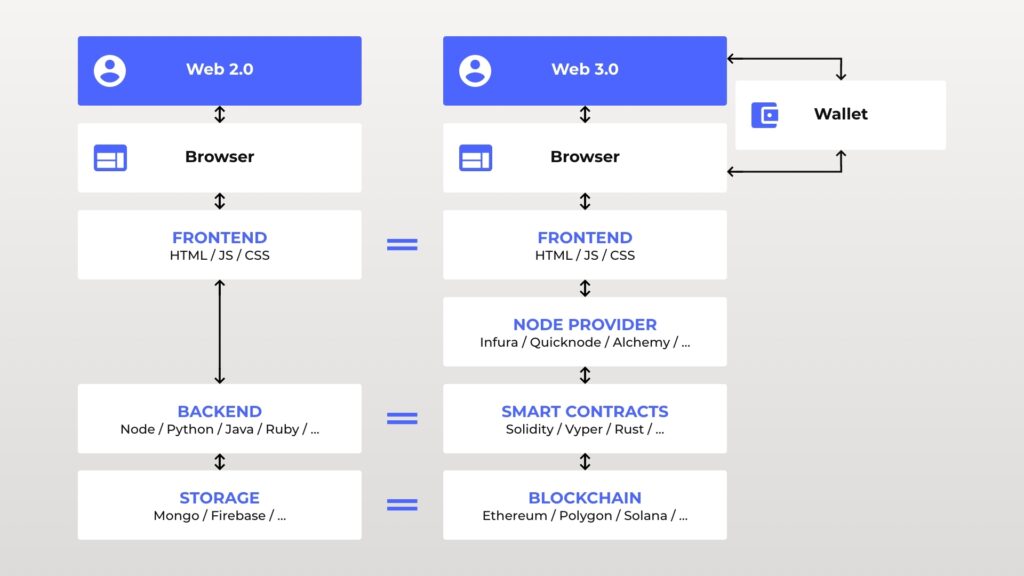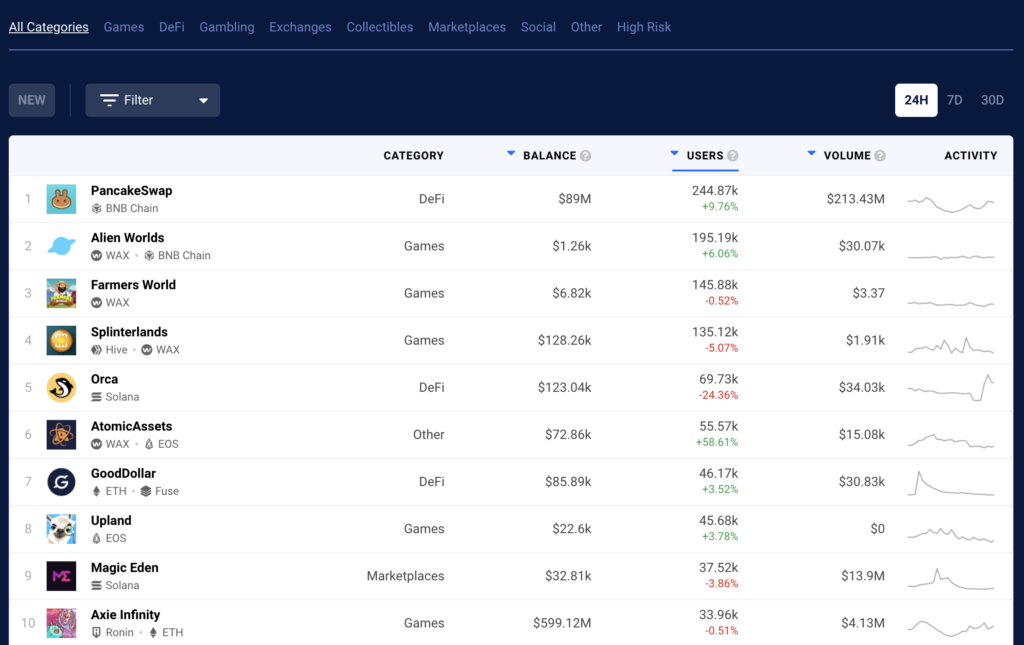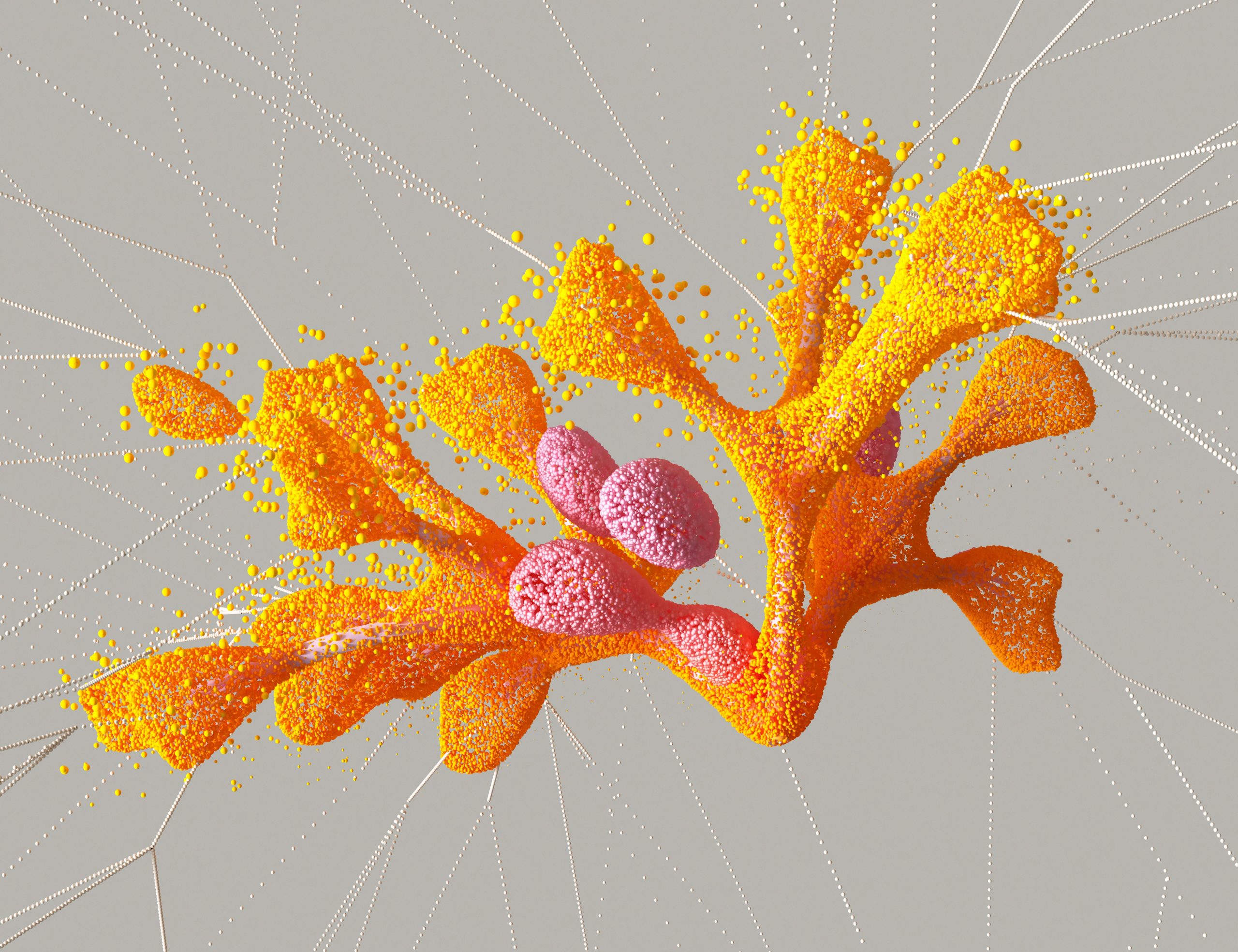If you are coming at it from a developer’s point of view, I think it is more important to explore the technical limitations and coding requirements first than actually finding the perfect use case from the get-go but I also admit that it can be a great motivation if you can work on something that provides actual real-world user value. Coming at it from an entrepreneur angle however, can be a much more difficult challenge this year as we see some drastic changes around us (from rapid inflation to extreme fluctuation in the crypto or NFT markets) which makes any kind of market prediction even trickier than before and it wasn’t ever an easy task to begin with.
So, here is an attempt to provide you an easy-to-grasp summary of the current state of the DApps space and talk about how the evolution might move forward once it could tackle its most pressing challenges.
A quick recap
Let’s start with a quick recap just to make sure we are all on the same page. DApp is short for decentralized application and at a quick glance they might look really similar to any “usual” web app but the main difference is that they use a decentralized technology (blockchain, DLT, peer-to-peer network..etc.) in the background instead of a central server which in practice also means that they are not (or less) controlled by a single entity (like a giant tech company) and more or less run like open-source code.
This is one of the main overarching ideas of web3.0, creating a more decentralized world wide web and establishing token-based economics. However, earlier this year Moxie Marlinspike, creator of Signal, articulated how Web3 is not as decentralized as it appears to be, mainly due to consolidation in the cryptocurrency field, including in blockchain application programming interfaces which are mainly controlled by companies like Alchemy and Infura, cryptocurrency exchanges which are mainly dominated by Binance, Coinbase, MetaMask, and OpenSea, and the stablecoin market which is currently dominated by Tether. Marlinspike also remarked that the new web resembles the old web. So, here is our first trend in decentralization and it is surprisingly centralization.
(These are all great examples of trending DApps by the way.)
The technical bits
As we previously learned, the big new idea that the Ethereum network brought compared to Bitcoin is that with its more complex data block structure it allows us to store code in the blocks (chain). This essentially makes it a distributed computing network where ETH (or Ether) the native currency of the platform represents the price of running your code. These snippets of code are referred to as smart contracts and can be written in multiple programming languages but the most common is still Solidity.

The frontend (the part of the app which you see in your browser, that you can interact with) uses the same technologies as web2.0, mostly HTML, CSS, JS.. etc. so there isn’t really a huge difference there but users are getting “identified” by their Wallet. There is a middle layer (that is not necessarily a must), this is where node providers sit. Their main goal is to provide access to the blockchain networks (mainnet and test networks as well).
The interesting part comes when we go to the next layer where smart contracts or usually a collection of smart contracts sit achieving a really similar task to backend APIs (or API calls) when compared to more traditional apps. This enables storing information on the blockchain and achieving the “business logic” behind your app.
Current state of the DApp space
Checking the main focus points of current DApp developments we can quickly see that due to the nature of the technology and how intertwined it is with the crypto space there are many DeFi (decentralized finances) solutions and there are also many DeX (Exchange) and Marketplace solutions for various digital assets. These can range from crypto or NFT-backed loans and automated insurance solutions to digital collectible or crypto swap apps. There is still a big hype (and a big risk) around the crypto and NFT space and people with their Wallets full of these assets are still looking for ways to use them.
As examples, I would recommend you to check out Curve, Yearn Finance or OpenSea.
Both DappRadar and State of the Dapps provide really valuable insight into the current user numbers, I recommend sorting by 24h or 7 days statistics. We can also easily see that monthly usage numbers can go into the millions which means the market is clearly growing day by day despite all the signs we see that would suggest otherwise. This makes us feel that articles stating that “DApps are struggling to gain users” were not exactly right a few years back.

On the other hand, the recent collapse of the former second-largest DeFi ecosystem, Terra and the crash of the associated LUNA token (and UST stablecoin), have accentuated the “dry season” that still affects the crypto landscape. DApp activity has hit its lowest point this year as 2.22 million daily Unique Active Wallets (UAW) connected to DApps in May. This number represents a 5% decrease month-over-month (MoM) but is still almost 32% higher than in May 2021.
Another main group is centered around gambling, gaming, and the metaverse with VCs investing over $2.5 billion into blockchain games in Q1 2022. The gaming category is resisting the crypto crash with only a 5% decrease in activity and 197% growth year-over-year. Alien Worlds has seen a 14% surge in activity, while Wax blockchain farming game Farmers World saw more than 166,000 active wallets in the previous seven days.
The idea of such play-to-earn games is that players can acquire potentially valuable in-game assets. These can range from skins or cards to a specific type of cryptocurrency… etc. The more players play, the more assets and more valuable assets they are able to collect. In traditional games, these assets are only valuable inside the given game but in play-to-earn blockchain games, they have real-world value as players can transfer these assets to the real world and sell them for cryptocurrency or “real” money on their own terms.
Such in-game collectibles most often come in the form of NFTs and despite the mainstream media often predicting the NFT bubble to burst soon, it seems it is more resilient than some thought so much so that it feels that the exposure alone that the blockchain space receives through the various new NFT projects like Goblintown or Otherside put the market in an entirely different position from the “crypto winter” in 2018.
Fees and chains
Ethereum is still one of the most well-known, most widely used, and the most well-documented networks out there which can be a real life saver during your project development. However, I know from personal experience that high gas fees can be a real pain. Not only the fact that transaction fees can be higher than for example the actual price of an NFT you are about to purchase but also the fact that despite the various calculation tools available, it is still hard to predict the exact amount of fees you will need to pay. We’ve even seen cases where a minting process didn’t fully go through but the full fee was still charged.
If you think about it, in any traditional environment this wouldn’t be accepted by the market. Also, for example, let’s imagine a blockchain-based social network DApp and now also imagine that there are gas fees for every action you do, to change your profile picture costs money. Who would use such an app, right? Well, you can’t approach these new systems with the old mindset, the business models need to be tweaked in order to make new ideas work. So, if you encourage usage by rewarding users for popular posts like if you have 200 000 views on your post you earn some crypto interest, the platform might actually start growing.
However, there are some other networks with much lower costs associated providing a viable alternative. Blockchains like EOS or Tron promise near-zero transaction fees. It might be misleading as they could seem free but that is not fully true so let’s just say that there are much cheaper options than Ethereum out there. At the same time, Ethereum is also galloping towards a much more economic version of itself with its 2.0 iteration on the horizon for a while now but it seems crypto fans are getting a bit impatient. This is proved by the trend we see, people and projects are moving their assets to so-called side chains. We see DApps like PancakeSwap appearing that are almost direct clones of already existing DApps, in this case, the popular Uniswap but with the main difference being is that while the latter is built on Ethereum, the former is on a Binance smart chain and therefore it can offer better economics.
The current DApp hot topic for us revolves around tokens which are also closely tied to launching your own DApp. If you would like to hear some more insights, please get in touch with us and start a chat as we would love to hear from you.


